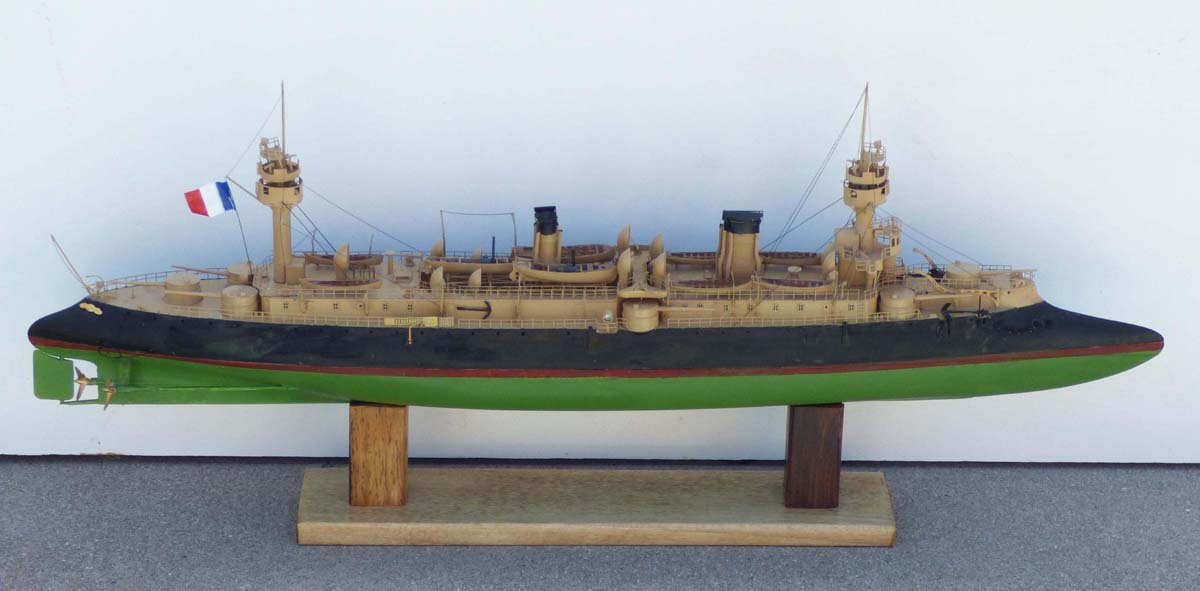
1/350 Dupuy de Lome (Combrig)
|
by Robert Apfelzweig |

1/350 Dupuy de Lome (Combrig)
Many naval historians consider the Dupuy de Lôme to be the first armored cruiser, a warship type that had a heyday of perhaps just a dozen years before the Royal Navy’s HMS Invincible made them all obsolete. French warships of the late 19th century were mostly an experimental and visually curious lot, and the Dupuy de Lôme is no exception, with its thick, widely separate military masts and oversize ram bow – which was not really intended as a ramming weapon (it was not armored), but merely to reduce the forecastle surface over which the forward guns could fire, reducing potential blast damage. The ship did feature a long armored belt of 100 mm (3.9 in.), and this qualifies it as an armored cruiser (most cruisers until then only deck armor, if any). Designed by the Jeune École in the late 1880s (and named for the naval architect Henry Dupuy de Lôme) as a commerce raider. She was armed with two single 194 mm (7.6 in.) guns in the wing turrets and six 164 mm (6.4 in.) guns in the fore and aft single turrets. Construction delays and faulty boilers postponed her commissioning until May 1895 (as the ship is portrayed in Combig’s kit); subsequent modifications included addition of a third funnel between the original two, addition of bilge keels, new boilers and reduction of the mainmast to a simple poleShe was placed in reserve in 1911 and nearly sold to Peru, but the sale fell through and she sat out World War I as a depot ship and never saw combat. Sold to a Belgian firm in October 1918, she was converted into a cargo ship (war losses had made these much in demand) and made a lengthy cruise to Brazil carrying a load of coal, breaking down several times and finally arriving in Pernambuco under tow in June 1920. It was then discovered that the coal in one of her holds was on fire. She was eventually towed across the Atlantic again that autumn, laying idle in Antwerp until scrapped in 1923.Combrig’s kit of the Dupuy de Lôme has many virtues and several flaws. The upper and lower hull sections are, unusually for Combrig, solid resin, but superbly cast, and fit together well. The instructions are more thorough than in previous kits but still have the disadvantage of not showing precisely how things fit together; unless one studies the assembly plans very carefully, and puts together the pieces in the illustrated order, problems will arise. As it was, the bridge, once assembled separately, did not quite fit onto its correct place on the deck (as outlined there) because two ventilators behind it would not provide enough room. Many parts, both brass and resin, are extremely small and fragile – every resin searchlight broke off its mounting stand when removed from the tree, and the barrels of the small 47 mm guns (which are placed in the lower platform of both masts) break off very easily. The two brass photoetch frets are quite detailed but there is the glaring error that, while the kit and instructions clearly show 30 rectangular openings in the bulkheads into which small grids (shaped like the Microsoft Windows™ logo) must be inserted, only 24 such grids are provided. Period photos of the ship show a rather limited rigging system, and the instructions don’t add much to that, so I mostly had to use guesswork to figure out where various lines went (which, as always, I made from stretched black sprue). Even with all the kit’s sophistication, Combrig still insists that modelers scratchbuild their own top masts, yardarms, propeller shafts, flagstaffs and funnel steampipes. The photoetched rails come in multiple segments without a bottom wire, making attachment tedious with CA glue needed beneath nearly every stanchion.
I’ve always been curious about the use by many navies in the predreadnought days of many small caliber weapons in those thick military masts; useful only at very close range, and largely against personnel, I’ve often wondered if the short fighting ranges then considered likely included equipping these ships with grappling hooks!
